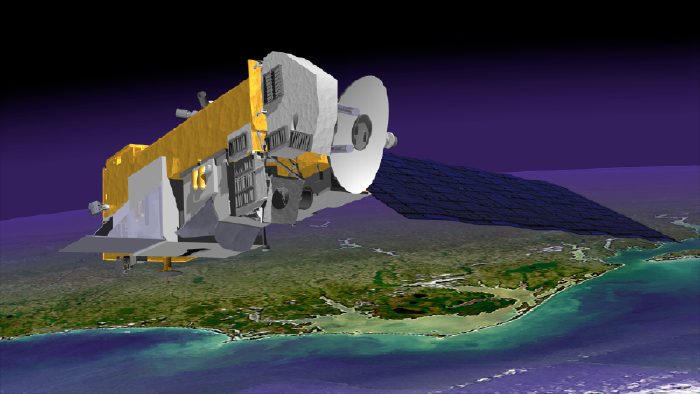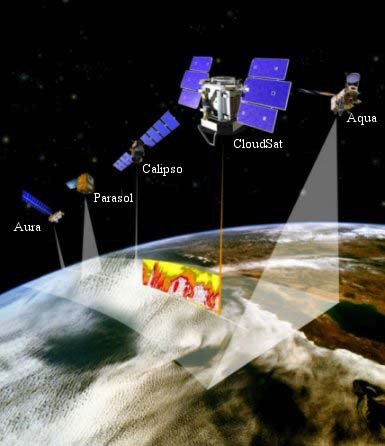| SPACE TODAY ONLINE COVERING SPACE FROM EARTH TO THE EDGE OF THE UNIVERSE | ||||||||||
| COVER | SOLAR SYSTEM | DEEP SPACE | SHUTTLES | STATIONS | ASTRONAUTS | SATELLITES | ROCKETS | HISTORY | GLOBAL LINKS | SEARCH |
Terra · Aqua · Aura
Aura: Studying Our Planet's Gasses
TERRA »» AQUA »» AURA »» CLOUDSAT »» CALIPSO »» OCO »» PARASOL »» A-TRAIN »»
One of the U.S. space agency's central missions is to understand and protect our planet. To advance the mission, NASA has the Earth Observing System (EOS) satellite Aura studying our planet's ozone, air quality and climate.
Click to enlarge NASA concept of Aura above Earth
Scientists use data gathered by Aura to conduct research on the composition, chemistry and dynamics of the Earth's upper and lower atmosphere. Aura examines trace gasses in the atmosphere so we can better understand global climate change, global warming, the global movement of polluted air, and ozone depletion in the stratosphere.
Aura is part of a flotilla of satellites flying in formation in space, including Terra, Aqua, CloudSat, Parasol and Calipso. CloudSat, Calipso and Parasol are scheduled for launch in 2005.
Together, their overlapping radars will give a more comprehensive picture of weather and climate down on Earth. The formation of orbiting satellites is referred to as the A-Train.
The A Train:
During their six-year missions in space, the environmental satellites Aura, Aqua and Terra are increasing our knowledge of how Earth's global water cycle works and how global climates change.
Satellite Launch Aura 2004 July 15 Aqua 2002 May 4 Terra 1999 December 18
The trio are among a flotilla of six spacecraft designed to fly in low polar orbits 438 miles above Earth. They satellites circle Earth 14 times a day. Aqua crosses the equator at approximately 1:30 AM and 1:30 PM, local time, about 3 hours behind Terra. Due to the instrument's narrow field of view, it takes about 16 days for Aqua to map the entire surface of the planet.
Aqua's afternoon observations and Terra's morning observations help scientists understand the daily cycle of key science parameters such as precipitation and ocean circulation.
After all six spacecraft are launched, the caravan will resemble a train of satellites flying around Earth. The A-Train reference comes from a jazz tune, Take the 'A' Train, about riding a subway to New York City's Harlem, written in 1941 by Billy Strayhorn and made famous by jazz maestro Duke Ellington. [ lyrics »» ]
Aura is the third satellite to fly in NASA's Earth Observing System. It is a sister ship to the first two launched, Terra and Aqua.
In orbit, the sequence of six satellites in the convoy runs from Aqua to Aura. Each is part of NASA's fleet of Earth watching satellites that the space agency refers to as the Earth Observing System.
Click to enlarge NASA artist concept of the A Train satellites above Earth
The ability to reduce risk is a benefit of flying satellites in formation. Sets of less costly, less expensive, less complex satellites means that failure of one does not kill an entire mission.
Aura's view from space of Earth's atmosphere and its chemistry will add to the global data already being collected by NASA's Earth Observing System (EOS) satellites – Terra monitoring land and Aqua observing Earth's water cycle.
Aura science:
The Earth Observing System (EOS) satellite Aura is a NASA mission to study the Earth's ozone, air quality and climate. This mission is designed to conduct research on the composition, chemistry and dynamics of the Earth's upper and lower atmosphere employing multiple instruments on a single satellite.
Aura is the third in a series of major Earth observing satellites to study the environment and climate change and is part of NASA's Earth Science Enterprise. The first and second missions, Terra and Aqua, are designed to study the land, oceans, and the Earth's radiation budget.
Aura's chemistry measurements will also follow up on measurements which began with NASA'S Upper Atmospheric Research Satellite and continue the record of satellite ozone data collected from the TOMS missions.
The EOS Aura satellite, instruments, launch, and science investigations are managed by NASA's Goddard Space Flight Center in Greenbelt, Maryland.
Aura science instruments:
Click to enlarge U.S. Air Force photo of the launch of Aura on July 15, 2004, from Vandenberg Air Force Base, California, on a Delta 2 rocket.
Flying at an altitude of 438 miles, Aura uses four science instruments to study Earth's atmosphere.
Aura's Instruments incorporate advanced technologies developed specifically for environmental satellites. Each instrument complements the others, enabling daily observations of Earth's atmospheric ozone layer, air quality, and key climate parameters.
Each of the school-bus-sized satellite's four science instruments is designed to monitor a different part of our global atmospheric system. They are:
- High Resolution Dynamics Limb Sounder (HIRDLS)
HIRDLS profiles ozone with the highest vertical resolution ever from space. The ozone measurements provide details on the lower stratosphere, where the largest ozone depletion has occurred.
[ details »» ]
- Microwave Limb Sounder (MLS)
MLS focuses on the upper troposphere and stratosphere, measuring microwave radiation emitted by ozone, chlorine compounds and many other traces gases. It watches how water vapor and ozone destructing compounds like chlorine and bromine pass between the troposphere and stratosphere. MLS is a microwave sensor able to measure trace gases inside of clouds.
[ details »» ] [ more »» ]
- Ozone Monitoring Instrument (OMI)
OMI monitors recovery of the stratospheric ozone layer. It measures both ultraviolet and visible radiation and provides daily high resolution global maps and profiles of ozone. OMI sees a swath about 1,616 miles, which allows complete daily coverage of the globe. OMI can map four of the US Environmental Protection Agency's six pollutants of primary concern for air quality and track aerosols near the Earth's surface.
[ details »» ]
- Tropospheric Emission Spectrometer (TES)
TES observes the heat emitted naturally from Earth's surface and atmosphere, as well as reflected sunlight. It provides night and day coverage of the atmosphere everywhere on the globe. TES is making the first direct global measurements of ozone in the lower atmosphere. It also will measure nitrates, water vapor and tropospheric ozone precursors, such as carbon monoxide. TES provides data for use in atmospheric chemistry prediction models. It helps scientists distinguish between man-made and natural impacts on air quality.
[ details »» ] [ more »» ]
The Greenhouse Effect:
The greenhouse effect observed on the surface of Earth is the result of water vapor, methane, carbon dioxide, nitrous oxide, tropospheric ozone, man-made chlorofluorocarbons, and other trace gases keeping the planet's surface warmer than it would be otherwise from direct sunlight alone.
Radiation Shortwave
radiationUltraviolet
lightLongwave
radiationInfrared light
heat energy
Those greenhouse gases allow ultraviolet light from the Sun to pass down through the atmosphere to heat Earth's surface. At the same time, the gases trap some of the rising infrared heat energy in the lower atmosphere, keeping it from escaping into space. Some of the heat is re-radiated back down to the surface where it heats surface temperatures higher than they would be if the gases were not in the atmosphere.
The process of trapping the infrared heat energy is the greenhouse effect. People around the world worry that increasing concentrations of greenhouse gases might enhance the greenhouse effect and cause global warming.
Earth benefits from some of the greenhouse effect. Scientists suggest that without a greenhouse overhead, the planet's surface would be 54 degrees Fahrenheit colder than it is. That would make life as we know it very difficult.
Atmospheric chemistry:
Earth's atmosphere is a dynamic, fluid system. Storms, volcanic eruptions and pollution shove particles up into the stratosphere, while large storms pull ozone down from the stratosphere into the lower atmosphere.
Scientists want to understand just exactly how chemicals move up and down between the layers of the atmosphere. Aura's instruments will measure the tropopause – the transition layer between the troposphere and stratosphere.
Water vapor is a greenhouse gas increasing in the stratosphere. Could the increase be caused by climate change or could it be due to changes in processes in tropical clouds? Aura's water vapor data combined with measurements by other satellites provide a better picture of climate change.
Aerosols have a big impact on climate. Some absorb heat, creating conditions that may warm the atmosphere, while others aerosols reflect sunlight, cooling the atmosphere.
TOMS and UARS:
Aura's measurements follow up on earlier work with NASA'S Upper Atmospheric Research Satellite (UARS) as well as ozone data collected from satellites carrying Total Ozone Mapping Spectrometers (TOMS).NASA's Goddard Space Flight Center manages the Aura mission. Aura was built for NASA by Northrop Grumman Space Technology in Redondo Beach, California. The Tropospheric Emission Spectrometer (TES) and the The Microwave Limb Sounder (MLS) were designed and built by NASA's Jet Propulsion Laboratory (JPL).
- The TOMS satellite instruments have been used on various satellites to measure local and global variations in ozone levels. TOMS could measure major aerosol producing events, such as large wildfires, large dust storms, and ash from major volcanic eruptions.
- Upper Atmosphere Research Satellite (UARS) on Sept. 15, 1991, from the Space Shuttle Discovery, scientists have gained a better understanding of the energy input, chemistry and dynamics of the upper atmosphere and the coupling between the upper and lower atmosphere. UARS, the first satellite dedicated to studying stratospheric science, focuses on the processes that lead to ozone depletion.
Earth Observing System:
Click to enlarge NASA's EOS logo
Scientists need to take measurements all over the world, over a long period of time, to be able to assemble the information needed to construct accurate computer models that will enable them to forecast the causes and effects of climate change.
At this time, the only feasible way to collect such widespread information is through the use of so-called remote sensors in space. That is, satellites orbiting Earth and carrying instruments that can measure things like temperature from a distance. Aura, Aqua and Terra are such satellites.
NASA built its Earth Observing System (EOS) as an international study of planet Earth. EOS has three main parts:EOS Direct Broadcast:
- a series of satellites designed to study the complexities of global change
- an advanced computer network called EOSDIS for processing, storing and distributing data
- teams of scientists around the globe studying the data
The EOS satellites broadcasts data for reception by anyone around the world.
Aqua broadcasts data from its science instruments AIRS/AMSU-A/HSB, AMSR-E, CERES, and MODIS on X-Band radio. The satellite broadcasts continuously except for five-minute interruptions once per obit when it contacts its ground stations at Poker Flat, Alaska, and Svalbard, Norway.
Terra broadcasts portions of the data from its MODIS science instrument on X-Band. The broadcast is continuous except when the satellite is dumping its play-back data to ground stations for 15 minutes each orbit, and when Terra is within line-of-sight of NASA Deep Space Network (DSN) stations at Goldstone, California, Canberra, Australia, and Madrid, Spain.
Anyone interested in obtaining direct broadcast data or establishing a downlink site should navigate to the EOS Direct Broadcast Web site.
[ EOS Direct Broadcast Web site »» ]
Earth Science Enterprise:
NASA has positioned EOS as the centerpiece of what it calls an Earth Science Enterprise (ESE). In the U.S. space agency's words, EOS is a scientific information gathering system and a data storage and retrieval system supporting a coordinated series of polar-orbiting and low inclination satellites for long-term global observations of the land surface, biosphere, solid Earth, atmosphere and oceans.
| Learn more: | |
Aura:
|
CloudSat:
|
| Terra | Aqua | Aura | Earth | Satellites | Solar System |
| Search STO | STO Cover | Questions | Feedback | © 2004 Space Today Online |



